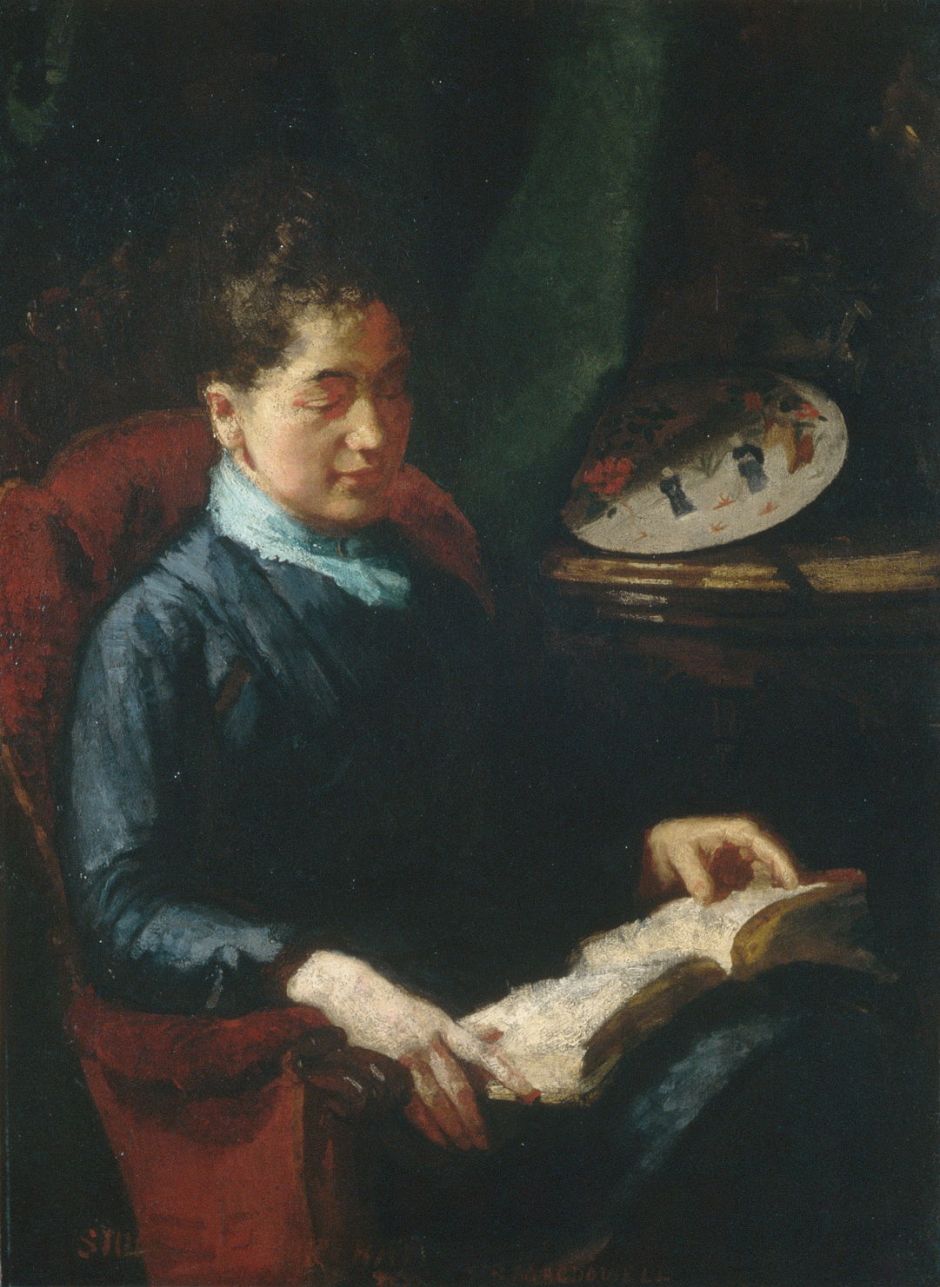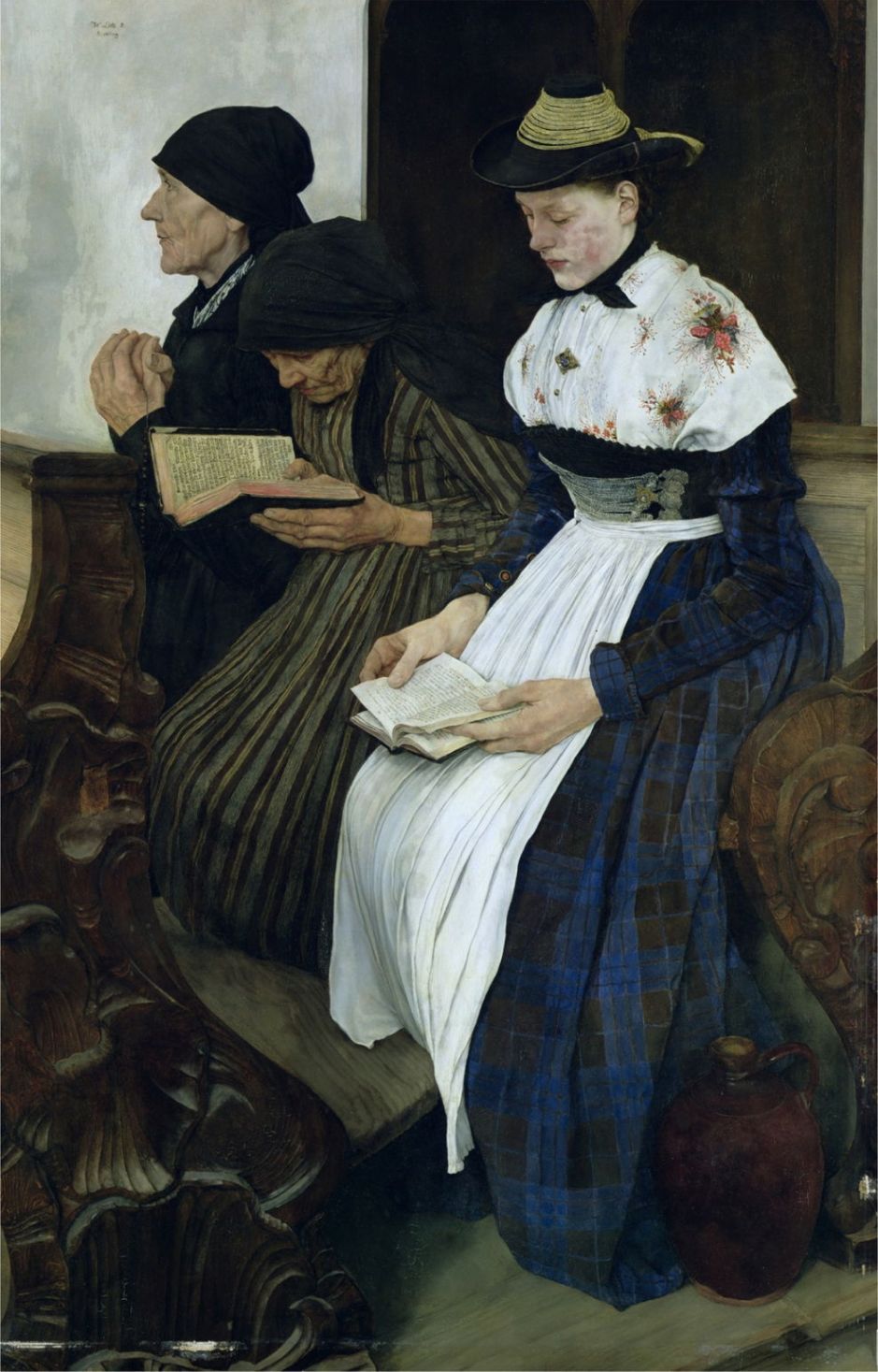In yesterday’s article, the first of three looking at paintings with the theme of reading and the book, I showed examples from the late Middle Ages through to the Pre-Raphaelites in the middle of the nineteenth century. Among the motifs which became steadily more popular from the Renaissance is that of a woman reading, which is the thread through my next selection of paintings from the latter half of the nineteenth century.
These start with the strangest of all these paintings, a work which I struggle to read in any rational way.

The Reader of Novels (1853) must be Antoine Wiertz’s most puzzling painting. A shapely and completely naked woman lies on her back, a book held above her face, reading avidly. Her bed is in a small compartment, a large mirror hanging above her lower body and legs. Her clothing is hung on the foot of the bed, and a floral garland on the top of the mirror. Beside her on the bed are several other books, and the hand of a horned figure is reaching up to those books from below and behind a curtain.
This has all the elements of what later became the ‘problem picture’, a visual riddle which the viewer was invited to solve by building a narrative which fitted the various clues. It could just be dismissing the reading of novels by women as a morally dangerous activity, but it seems too elaborate for that. I wonder if the woman is part of a ‘live peep show’, and passing the time by reading, perhaps, or just a prostitute in her booth in a brothel (although the bed seems rather small to accommodate any partner).
In complete contrast, here’s one of Osman Hamdi Bey’s superb paintings which demonstrates that reading as devotion among religious scholars isn’t confined to Christians.

Bey learned his highly-detailed salon style under Gérôme and Boulanger in Paris, and The Scholar from 1878 is one of his better examples.

Although far less well-known than her husband, Susan Macdowell Eakins was an accomplished painter in her own right. Her Woman Reading from 1879-84 is conventional, and is presumed to have been painted before her marriage in 1884, although it appears more consistent in style with some of her works from the period after her husband Thomas’s death. It features a touch of Japonisme, perhaps, in the decorated plate peeping out from the curtain behind.
For women to read they needed better education, something the French Third Republic was proud to invest in.

Jean-Baptiste Jules Trayer’s wonderful watercolour of A Breton Infants School from 1882 predates any celebration of Republican policy: the crucifix high on the wall at the right demonstrates that this is one of the older Catholic schools. It shows a teacher helping one of her students with her writing, in a class entirely wearing traditional Breton costume. There is clearly room for improvement, though, as one girl is sleeping on her book, tired out from her early morning work on the family farm, no doubt.

Wilhelm Leibl’s Three Women in Church from the same year combines both reading as religious devotion with two women reading. This painting is believed to have been a major influence on Harriet Backer’s masterwork Christening in Tanum Church (1892).

Meanwhile, in the more Aesthetic world of Francis Davis Millet’s Reading the Story of Oenone (c 1883), four beautiful women in classical robes are savouring the now-obscure story of another woman, Oenone.
In spite of improving education and increasing literacy among women, some books were still the preserve of men. From the earliest days of the printing press, they pandered to male sexuality and other matters which had to be kept well away from the weak mind of the woman. Sometimes, though, those locked libraries were invaded.

Félix-Henri Giacomotti, a friend of William Bouguereau, painted this satirical scene of Forbidden Literature in 1886, with two interrelated surprises. Five young women have found their way into a private library containing ‘forbidden literature’, and are showing various signs of surprise and shock at what they have discovered and read there. They have then been surprised by the entry of an older woman, possibly their mother, who clearly wasn’t expecting to find them swooning over explicit content.

Berthe Morisot’s pure Impressionist Reading from 1888 is all sweetness and light, though. This young woman sits reading in a conservatory. Her head is slightly bowed as she looks intently at the book she holds in both hands, just above her lap. Although many of Morisot’s paintings feature her daughter Julie, the model in this case was Jeanne Bonnet.
Finally, for today, comes one of Lovis Corinth’s early paintings, made at about the time that he adopted that name, and was finding his form in painting figures.

Corinth’s Woman Reading shows his early style maturing well, with subtle use of light.
In tomorrow’s final episode, I’ll show paintings into the first decade of the twentieth century, when a woman reading became distinctly dangerous.

